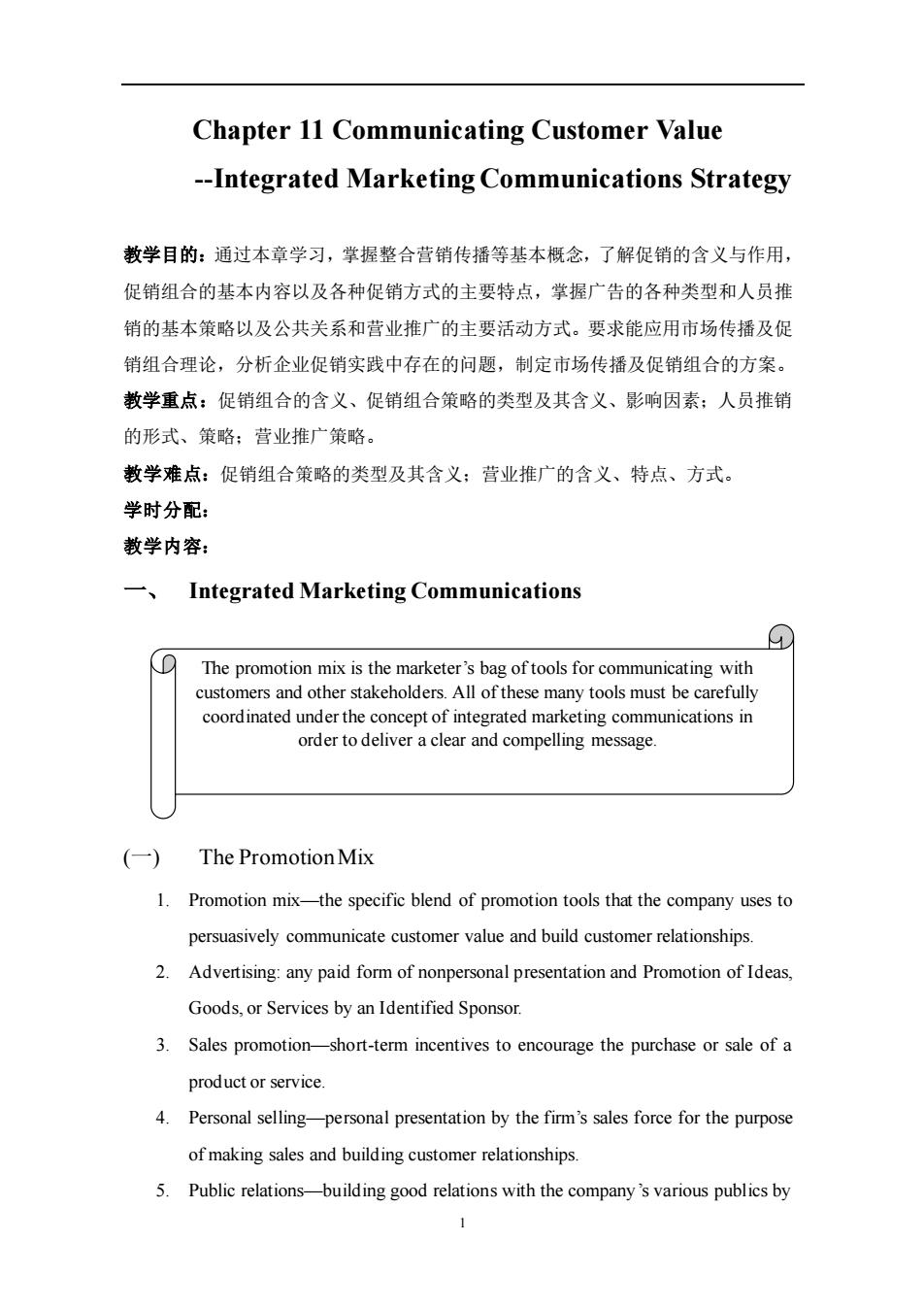
Chapter 11 Communicating Customer Value -Integrated Marketing Communications Strategy 教学目的:通过本章学习,掌握整合营销传播等基本概念,了解促销的含义与作用, 促销组合的基本内容以及各种促销方式的主要特点,掌握广告的各种类型和人员推 销的基本策略以及公共关系和营业推广的主要活动方式。要求能应用市场传播及促 销组合理论,分析企业促销实践中存在的问题,制定市场传播及促销组合的方案。 教学重点:促销组合的含义、促销组合策略的类型及其含义、影响因素:人员推销 的形式、策略;营业推广策略。 教学难点:促销组合策略的类型及其含义:营业推广的含义、特点、方式。 学时分配: 教学内容: 一、Integrated Marketing Communications The promotion mix is the marketer's bag of tools for communicating with custo ers and other stakeholders.All of these many tools must be carefully coordinated under the ncept of integrated marketing communications in order to deliver a clear and compelling message. (-)The Promotion Mix 1.Promotion mix-the specific blend of promotion tools that the company uses to persuasively communicate customer value and build customer relationships. 2.Advertising:any paid form of nonpersonal presentation and Promotion of Ideas. Goods,or Services by an Identified Sponsor. 3.Sales promotion-short-term incentives to encourage the purchase or sale of a product or service 4.Personal selling-personal presentation by the firm's sales force for the purpose of making sales and building customer relationships. 5.Public relations-building good relations with the company's various publics by
1 Chapter 11 Communicating Customer Value -Integrated Marketing Communications Strategy 教学目的:通过本章学习,掌握整合营销传播等基本概念,了解促销的含义与作用, 促销组合的基本内容以及各种促销方式的主要特点,掌握广告的各种类型和人员推 销的基本策略以及公共关系和营业推广的主要活动方式。要求能应用市场传播及促 销组合理论,分析企业促销实践中存在的问题,制定市场传播及促销组合的方案。 教学重点:促销组合的含义、促销组合策略的类型及其含义、影响因素;人员推销 的形式、策略;营业推广策略。 教学难点:促销组合策略的类型及其含义;营业推广的含义、特点、方式。 学时分配: 教学内容: 一、 Integrated Marketing Communications (一) The Promotion Mix 1. Promotion mix—the specific blend of promotion tools that the company uses to persuasively communicate customer value and build customer relationships. 2. Advertising: any paid form of nonpersonal presentation and Promotion of Ideas, Goods, or Services by an Identified Sponsor. 3. Sales promotion—short-term incentives to encourage the purchase or sale of a product or service. 4. Personal selling—personal presentation by the firm’s sales force for the purpose of making sales and building customer relationships. 5. Public relations—building good relations with the company’s various publics by The promotion mix is the marketer’s bag of tools for communicating with customers and other stakeholders. All of these many tools must be carefully coordinated under the concept of integrated marketing communications in order to deliver a clear and compelling message
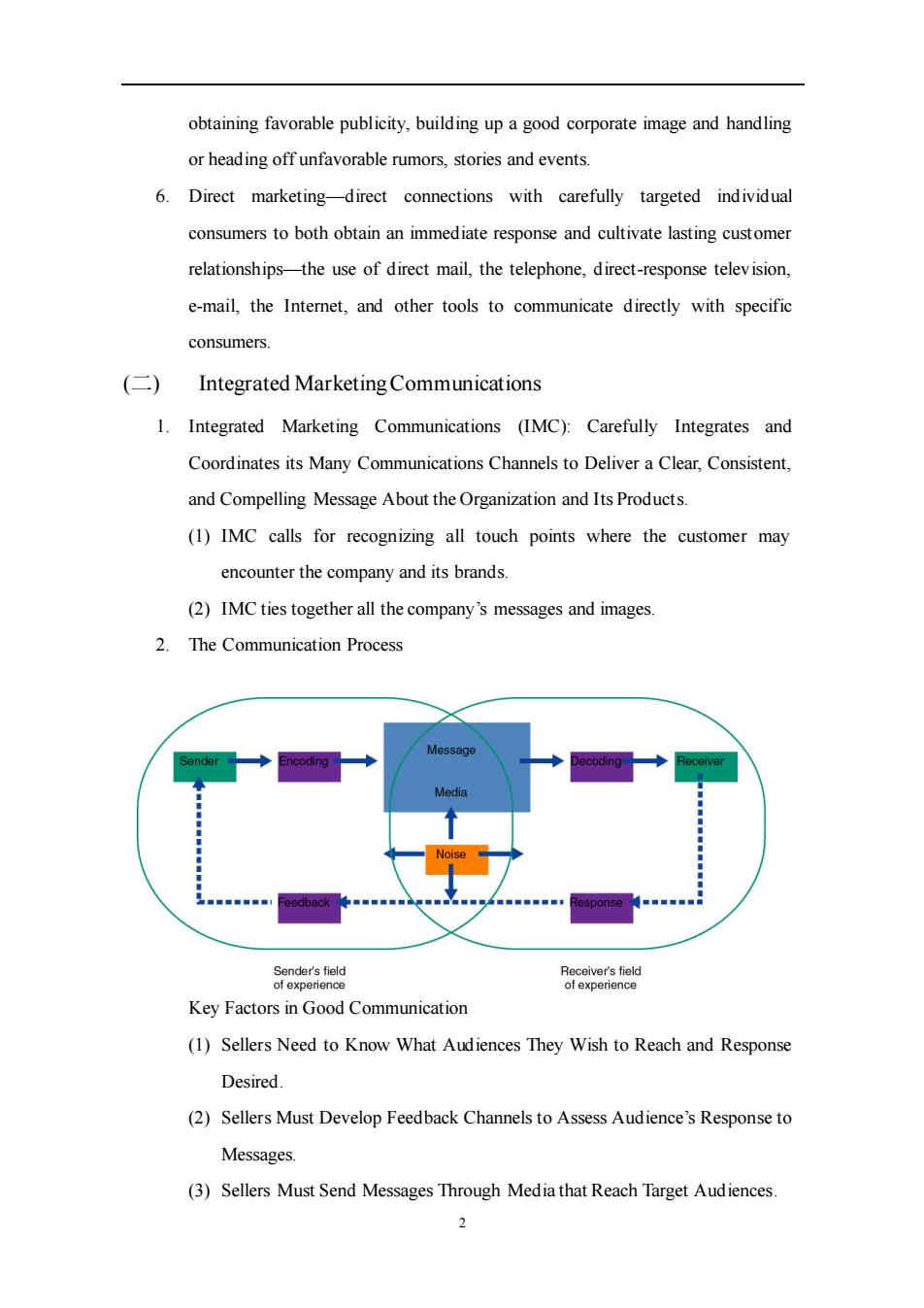
obtaining favorable publicity,building up a good corporate image and handling or heading off unfavorable rumors,stories and events. 6. Direct marketing-direct connections with carefully targeted individual consumers to both obtain an immediate response and cultivate lasting customer relationships-the use of direct mail,the telephone.direct-response television. e-mail,the Intemet,and other tools to communicate directly with specific consumers. (二) Integrated Marketing Communications 1.Integrated Marketing Communications (IMC):Carefully Integrates and Coordinates its Many Communications Channels to Deliver a Clear,Consistent, and Compelling Message About the Organization and Its Products. (1)IMC calls for recognizing all touch points where the customer may encounter the company and its brands (2)IMC ties together all the company's messages and images. 2.The Communication Process mn8rae Key Factors in Good Communication (1)Sellers Need to Know What Audiences They Wish to Reach and Response Desired. (2)Sellers Must Develop Feedback Channels to Assess Audience's Response to Messages. (3)Sellers Must Send Messages Through Media that Reach Target Audiences
2 obtaining favorable publicity, building up a good corporate image and handling or heading off unfavorable rumors, stories and events. 6. Direct marketing—direct connections with carefully targeted individual consumers to both obtain an immediate response and cultivate lasting customer relationships—the use of direct mail, the telephone, direct-response television, e-mail, the Internet, and other tools to communicate directly with specific consumers. (二) Integrated Marketing Communications 1. Integrated Marketing Communications (IMC): Carefully Integrates and Coordinates its Many Communications Channels to Deliver a Clear, Consistent, and Compelling Message About the Organization and Its Products. (1) IMC calls for recognizing all touch points where the customer may encounter the company and its brands. (2) IMC ties together all the company’s messages and images. 2. The Communication Process Key Factors in Good Communication (1) Sellers Need to Know What Audiences They Wish to Reach and Response Desired. (2) Sellers Must Develop Feedback Channels to Assess Audience’s Response to Messages. (3) Sellers Must Send Messages Through Media that Reach Target Audiences
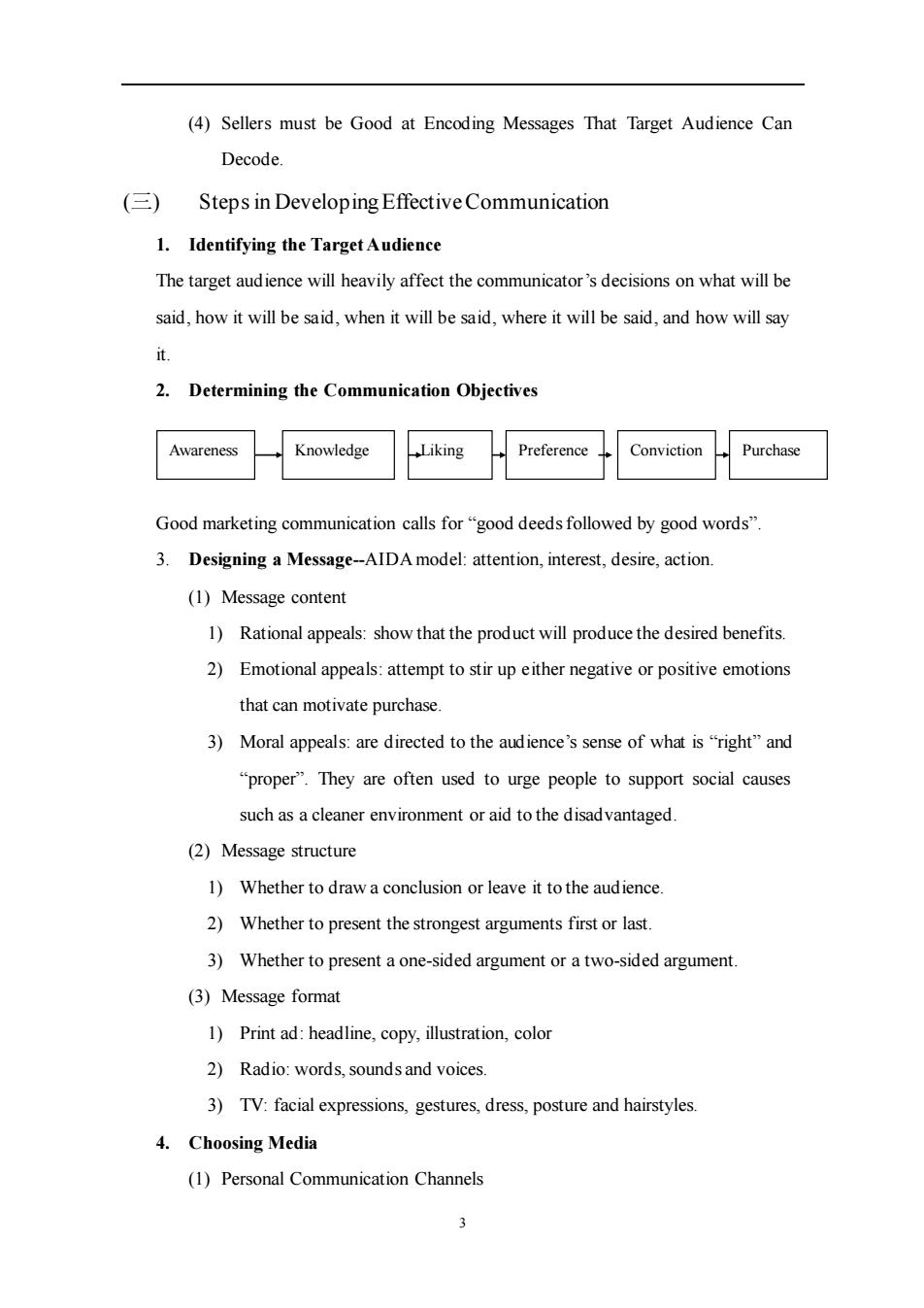
(4)Sellers must be Good at Encoding Messages That Target Audience Can Decode. (三) Steps in Developing Effective Communication 1.Identifying the Target Audience The target audience will heavily affect the communicator's decisions on what will be said,how it will be said,when it will be said,where it will be said,and how will say it. 2.Determining the Communication Objectives Good marketing communication calls for"good deeds followed by good words" 3.Designing a Message-AIDAmodel:attention,interest,desire,action. (1)Message content 1)Rational appeals:show that the product will produce the desired benefits. 2)Emotional appeals:attempt to stir up either negative or positive emotions that can motivate purchase 3)Moral appeals:are directed to the audience's sense of what is"right"and "proper".They are often used to urge people to support social causes such as acleaner environment or aid tothe disadvantaged (2)Message structure 1)Whether to draw a conclusion or leave it to the audience 2)Whether to present the strongest arguments first or last. 3)Whether to present a one-sided argument or a two-sided argument (3)Message format 1)Print ad:headline,copy,illustration,color 2)Radio:words,soundsand voices. 3)TV:facial expressions,gestures,dress,posture and hairstyles 4.Choosing Media (1)Personal Communication Channels
3 (4) Sellers must be Good at Encoding Messages That Target Audience Can Decode. (三) Steps in Developing Effective Communication 1. Identifying the Target Audience The target audience will heavily affect the communicator’s decisions on what will be said, how it will be said, when it will be said, where it will be said, and how will say it. 2. Determining the Communication Objectives Good marketing communication calls for “good deeds followed by good words”. 3. Designing a Message-AIDA model: attention, interest, desire, action. (1) Message content 1) Rational appeals: show that the product will produce the desired benefits. 2) Emotional appeals: attempt to stir up either negative or positive emotions that can motivate purchase. 3) Moral appeals: are directed to the audience’s sense of what is “right” and “proper”. They are often used to urge people to support social causes such as a cleaner environment or aid to the disadvantaged. (2) Message structure 1) Whether to draw a conclusion or leave it to the audience. 2) Whether to present the strongest arguments first or last. 3) Whether to present a one-sided argument or a two-sided argument. (3) Message format 1) Print ad: headline, copy, illustration, color 2) Radio: words, sounds and voices. 3) TV: facial expressions, gestures, dress, posture and hairstyles. 4. Choosing Media (1) Personal Communication Channels Awareness Knowledge Liking Preference Conviction Purchase
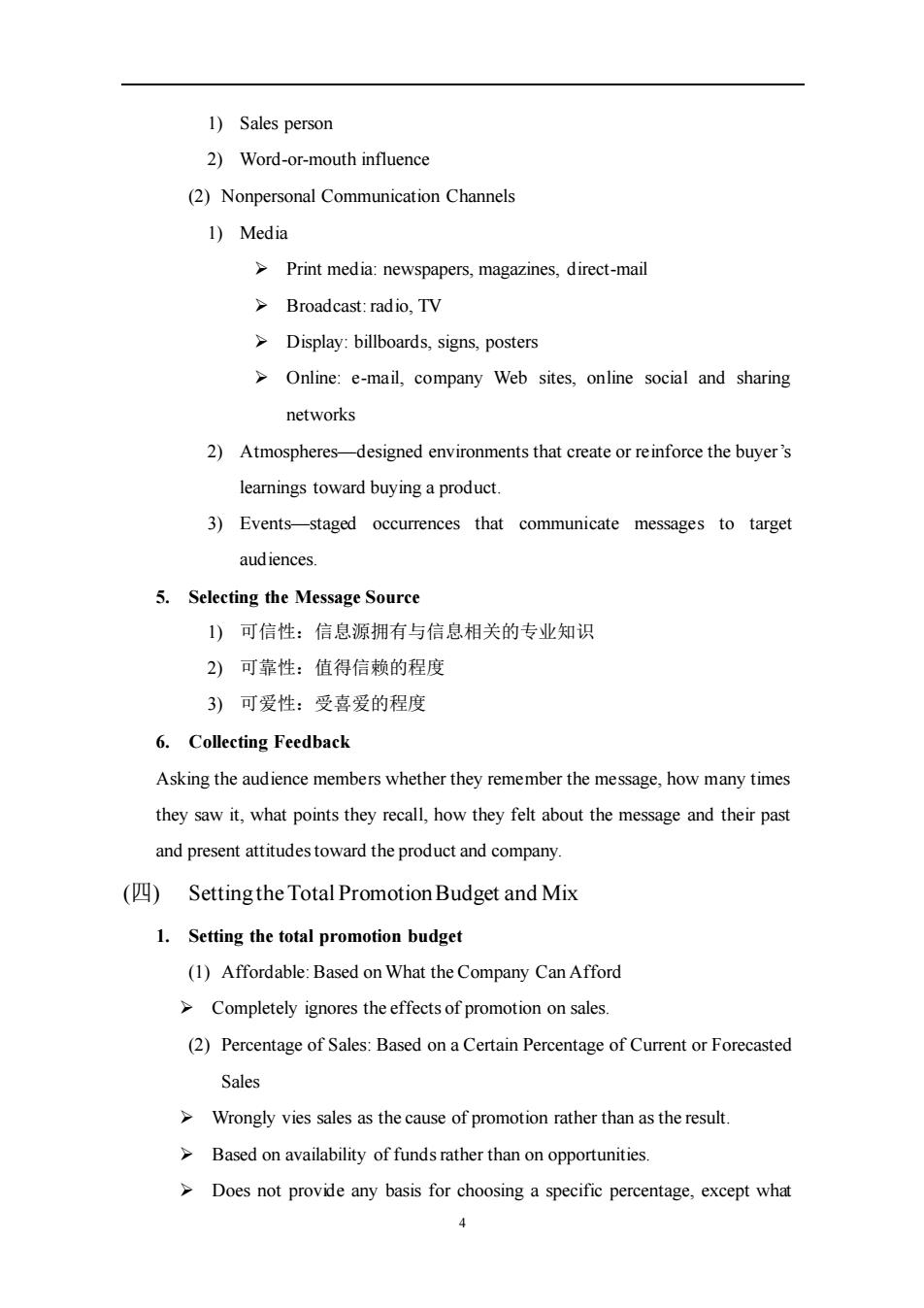
1)Sales person 2)Word-or-mouth influence (2)Nonpersonal Communication Channels 1)Media Print media:newspapers,magazines,direct-mail >Broadcast:radio,TV Display:billboards,signs,posters >Online:e-mail,company Web sites,online social and sharing networks 2)Atmospheres-designed environments that create or reinforce the buyer's leamnings toward buying a product. 3)Events-staged occurrences that communicate messages to target audiences. 5.Selecting the Message Source 1)可信性:信息源拥有与信息相关的专业知识 2)可靠性:值得信赖的程度 3)可爱性:受喜爱的程度 6.Collecting Feedback Asking the audience members whether they remember the message,how many times they saw it,what points they recall,how they felt about the message and their past and present attitudes toward the product and company. (Setting the Total Promotion Budget and Mix 1.Setting the total promotion budget (1)Affordable:Based on What the Company Can Afford >Completely ignores the effects of promotion on sales. (2)Percentage of Sales:Based on a Certain Percentage of Current or Forecasted Sales Wrongly vies sales as the cause of promotion rather than as the result >Based on availability of funds rather than on opportunities. >Does not provide any basis for choosing a specific percentage,except what 4
4 1) Sales person 2) Word-or-mouth influence (2) Nonpersonal Communication Channels 1) Media ➢ Print media: newspapers, magazines, direct-mail ➢ Broadcast: radio, TV ➢ Display: billboards, signs, posters ➢ Online: e-mail, company Web sites, online social and sharing networks 2) Atmospheres—designed environments that create or reinforce the buyer’s learnings toward buying a product. 3) Events—staged occurrences that communicate messages to target audiences. 5. Selecting the Message Source 1) 可信性:信息源拥有与信息相关的专业知识 2) 可靠性:值得信赖的程度 3) 可爱性:受喜爱的程度 6. Collecting Feedback Asking the audience members whether they remember the message, how many times they saw it, what points they recall, how they felt about the message and their past and present attitudes toward the product and company. (四) Setting the Total Promotion Budget and Mix 1. Setting the total promotion budget (1) Affordable: Based on What the Company Can Afford ➢ Completely ignores the effects of promotion on sales. (2) Percentage of Sales: Based on a Certain Percentage of Current or Forecasted Sales ➢ Wrongly vies sales as the cause of promotion rather than as the result. ➢ Based on availability of funds rather than on opportunities. ➢ Does not provide any basis for choosing a specific percentage, except what
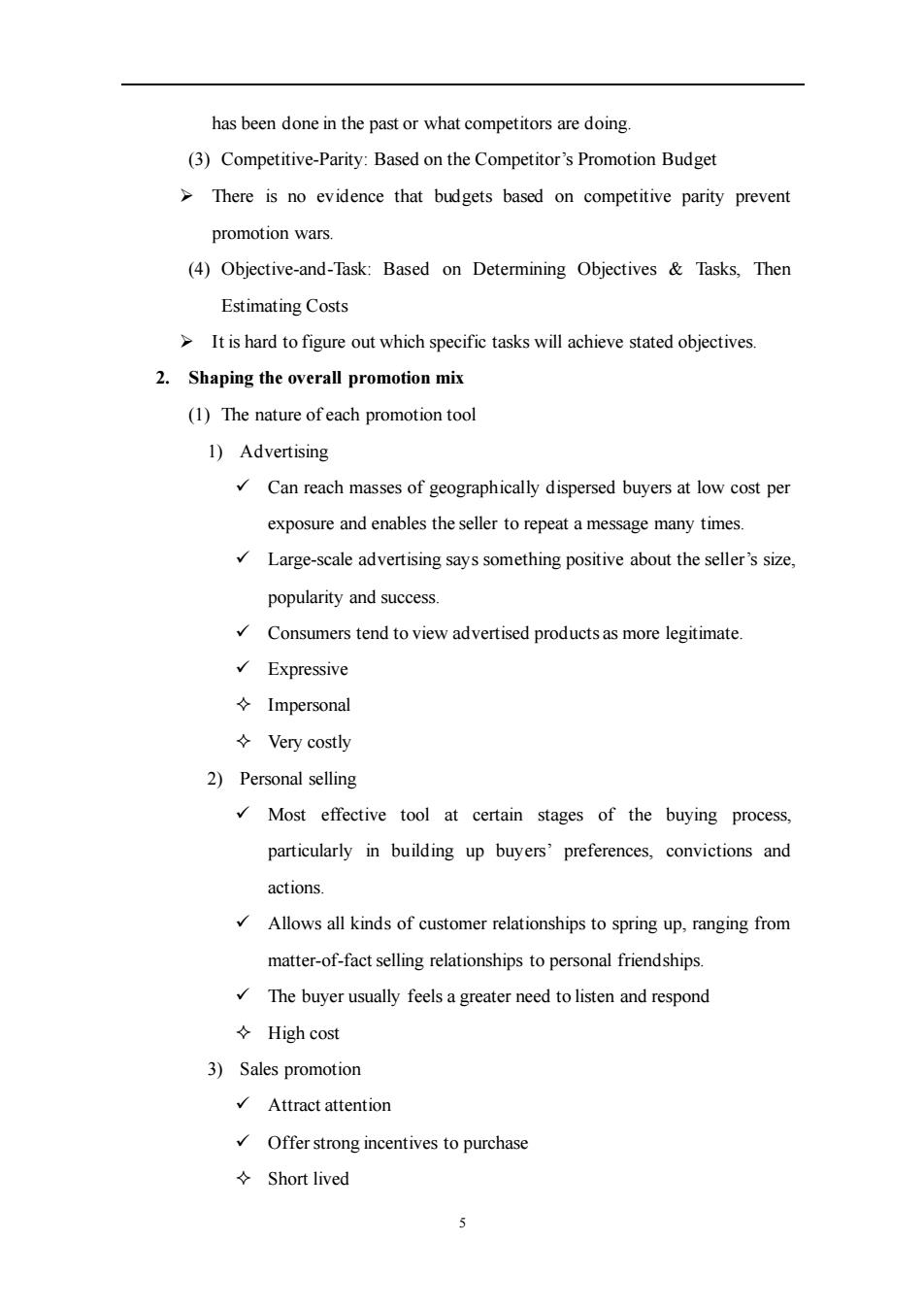
has been done in the past or what competitors are doing. (3)Competitive-Parity:Based on the Competitor's Promotion Budget >There is no evidence that budgets based on competitive parity prevent promotion wars. (4)Objective-and-Task:Based on Determining Objectives&Tasks,Then Estimating Costs It is hard to figure out which specific tasks will achieve stated objectives. 2.Shaping the overall promotion mix (1)The nature ofeach promotion tool 1)Advertising Can reach masses of geographically dispersed buyers at low cost per exposure and enables the seller to repeat a message many times. Large-scale advertising says something positive about the seller's size popularity and success. Consumers tend to view advertised products as more legitimate. √Expressive Impersonal 女Very costly 2)Personal selling Most effective tool at certain stages of the buying process particularly in building up buyers'preferences,convictions and actions. Allows all kinds of customer relationships to spring up,ranging from matter-of-fact selling relationships to personal friendships. The buyer usually feels a greater need to listen and respond 女High cost 3)Sales promotion Attract attention Offer strong incentives to purchase ◇Short lived 5
5 has been done in the past or what competitors are doing. (3) Competitive-Parity: Based on the Competitor’s Promotion Budget ➢ There is no evidence that budgets based on competitive parity prevent promotion wars. (4) Objective-and-Task: Based on Determining Objectives & Tasks, Then Estimating Costs ➢ It is hard to figure out which specific tasks will achieve stated objectives. 2. Shaping the overall promotion mix (1) The nature of each promotion tool 1) Advertising ✓ Can reach masses of geographically dispersed buyers at low cost per exposure and enables the seller to repeat a message many times. ✓ Large-scale advertising says something positive about the seller’s size, popularity and success. ✓ Consumers tend to view advertised products as more legitimate. ✓ Expressive Impersonal Very costly 2) Personal selling ✓ Most effective tool at certain stages of the buying process, particularly in building up buyers’ preferences, convictions and actions. ✓ Allows all kinds of customer relationships to spring up, ranging from matter-of-fact selling relationships to personal friendships. ✓ The buyer usually feels a greater need to listen and respond High cost 3) Sales promotion ✓ Attract attention ✓ Offer strong incentives to purchase Short lived